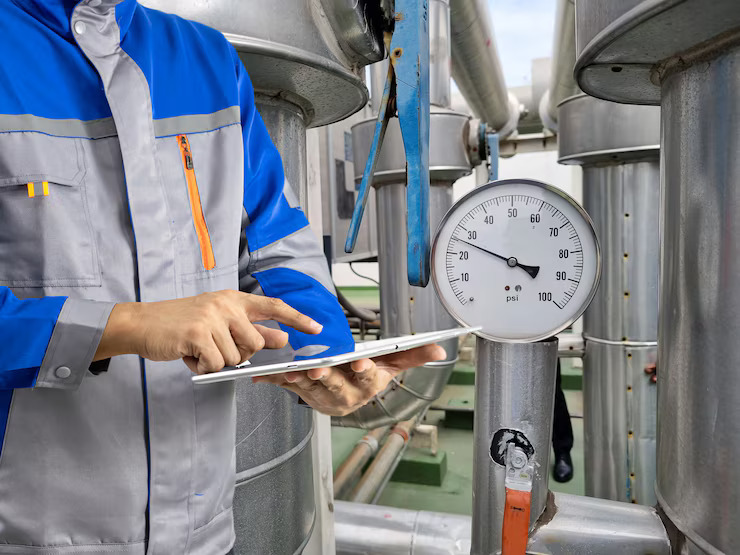In industries where the accurate measurement of fluids is critical—such as oil and gas, pharmaceuticals, water treatment, and food processing—flow meters play a vital role. However, like any other measuring instrument, flow meters can drift over time due to wear, environmental conditions, or mechanical changes. To ensure ongoing accuracy and reliability, flow meter calibration is essential.
What is Flow Meter Calibration?
Flow meter calibration is the process of comparing the measurements of a flow meter against a standard reference to detect and correct any inaccuracies. It ensures that the flow meter provides accurate readings for the flow of liquids or gases through pipes or channels.
Over time, even a high-quality flow meter can deviate from its original accuracy due to factors such as:
- Mechanical wear and tear
- Temperature and pressure fluctuations
- Chemical exposure
- Vibration or improper installation
Calibration identifies these deviations and allows for adjustment or correction, ensuring that the instrument delivers precise data.
Why is Calibration Important?
1. Accuracy and Reliability
The primary reason for calibration is to ensure that the flow meter is measuring accurately. Inaccurate readings can lead to:
- Product wastage
- Process inefficiencies
- Faulty billing
- Safety hazards
2. Regulatory Compliance
Many industries must comply with international and national standards like ISO, NABL, or API. Regular calibration ensures compliance with these regulations and avoids legal or financial penalties.
3. Quality Assurance
In sectors like pharmaceuticals and food processing, where even small errors in fluid measurement can impact product quality, calibration is crucial to maintain consistency and safety.
4. Cost Control
Over-measuring or under-measuring flow rates can lead to financial losses. Calibrated flow meters help maintain exact control over inventory and resources.
Types of Flow Meters That Require Calibration
Flow meter calibration is applicable to a wide range of devices, including:
- Electromagnetic flow meters – used for conductive liquids like water or slurry
- Ultrasonic flow meters – measure flow via sound waves
- Turbine flow meters – used in clean, steady flows like oils and chemicals
- Coriolis flow meters – highly accurate, used for both mass and density measurements
- Thermal mass flow meters – ideal for gases
- Positive displacement meters – used for high-viscosity fluids
- Vortex flow meters – used in various industrial applications
Each type of meter has unique calibration needs and methods.
Methods of Flow Meter Calibration
There are several accepted methods for calibrating flow meters. The choice depends on the meter type, the medium (liquid or gas), and the required precision.
1. Gravimetric Method
- The most accurate method, especially for liquids.
- Involves collecting a known mass of fluid over time and comparing it to the meter’s reading.
- Ideal for high-precision applications like pharmaceuticals.
2. Volumetric Method
- Measures volume using a calibrated container or tank.
- Suitable for lower-accuracy requirements or routine checks.
3. Master Meter Method
- A highly accurate reference flow meter is used in series with the meter being tested.
- Used when the medium is difficult to handle (e.g., corrosive fluids or gases).
4. Dynamic Method
- Involves the actual process flow in live pipelines.
- Often used in the oil and gas industry where static testing is not feasible.
Each method has its pros and cons based on application, accuracy requirements, and environment.
Calibration Standards and Certification
In India and globally, calibration services often follow international standards such as:
- ISO/IEC 17025 – the standard for testing and calibration laboratories
- NABL Accreditation – certifies that the lab is competent to perform calibrations
- API MPMS – petroleum industry calibration standards
- OIML – for legal metrology
Using an NABL-accredited laboratory ensures that your calibration data is traceable to national and international standards, enhancing credibility and acceptance across industries.
Frequency of Calibration
The frequency of flow meter calibration depends on several factors:
- Industry regulations
- Manufacturer’s recommendation
- Process criticality
- Frequency of use
- Environmental factors
In general, most industries follow a 6-month to 1-year calibration cycle, but critical applications may require more frequent checks.
In-House vs. Third-Party Calibration
In-House Calibration
- Done on-site using portable calibration rigs.
- Convenient but limited to certain meter types and accuracy levels.
Third-Party/NABL Lab Calibration
- Offers high-accuracy calibration with traceable results.
- Recommended for final calibration, certifications, or when legal compliance is required.
Many companies choose a hybrid approach—routine in-house checks and annual third-party certification.
Documentation and Reporting
A complete calibration process includes a detailed calibration certificate, which should include:
- Flow meter details (make, model, serial number)
- Calibration method and environment conditions
- Reference standards used
- Before and after calibration readings
- Measurement uncertainty
- Technician signature and certification validity
Proper documentation helps during audits, inspections, and troubleshooting.
Conclusion
Flow meter calibration is a critical part of maintaining industrial efficiency, ensuring product quality, and meeting regulatory requirements. By regularly your flow meter calibration—either in-house or through NABL-accredited laboratories—you safeguard the accuracy of your fluid measurement processes and avoid costly errors.


